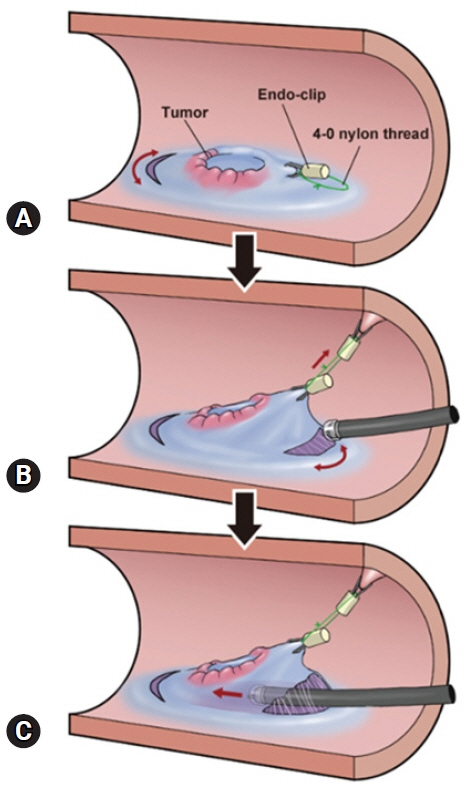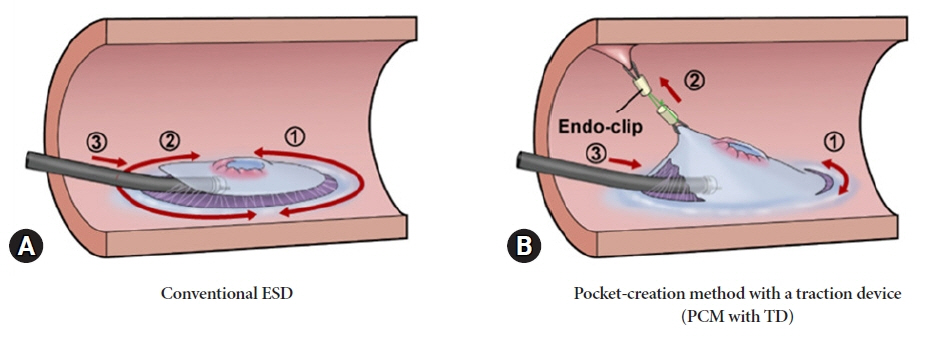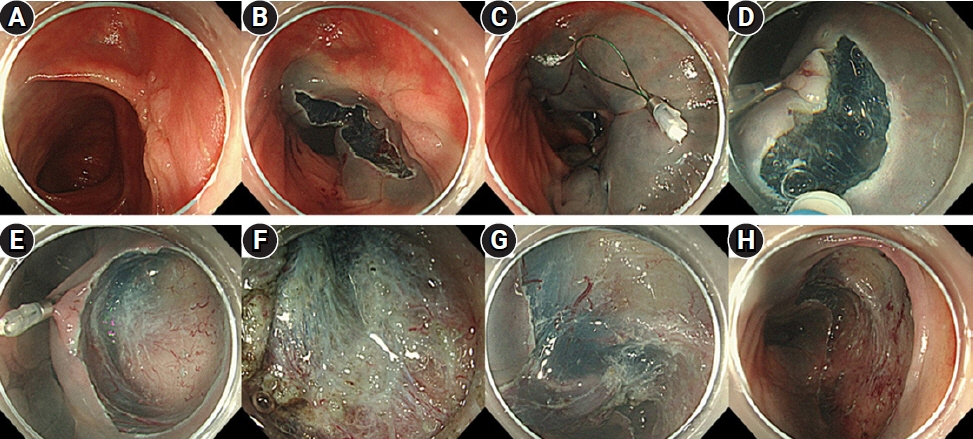Clin Endosc.
2022 Sep;55(5):655-664. 10.5946/ce.2022.009.
Efficacy of the pocket-creation method with a traction device in endoscopic submucosal dissection for residual or recurrent colorectal lesions
- Affiliations
-
- 1Department of Gastroenterology, The Cancer Institute Hospital of Japanese Foundation for Cancer Research, Tokyo, Japan
- 2Division of Gastroenterology and Hepatology, Department of Internal Medicine, The Jikei University School of Medicine, Tokyo, Japan
- 3Department of Endoscopy, The Jikei University School of Medicine, Tokyo, Japan
- 4Division of Nephrology and Hypertension, Department of Internal Medicine, The Jikei University School of Medicine, Tokyo, Japan
- KMID: 2533305
- DOI: http://doi.org/10.5946/ce.2022.009
Abstract
- Background/Aims
Endoscopic submucosal dissection (ESD) for residual or recurrent colorectal lesions after incomplete resection is challenging because of severe fibrosis. This study aimed to compare the efficacy of the pocket-creation method (PCM) with a traction device (TD) with that of conventional ESD for residual or recurrent colorectal lesions.
Methods
We retrospectively studied 72 patients with residual or recurrent colorectal lesions resected using ESD. Overall, 31 and 41 lesions were resected using PCM with TD and conventional ESD methods, respectively. We compared patient background and treatment outcomes between the PCM with TD and conventional ESD groups, respectively. The primary endpoints were en bloc resection and R0 resection rates. The secondary endpoints were the dissection speed and incidence of adverse events.
Results
En bloc resection was feasible in all cases with PCM with TD, but failed in 22% of cases of conventional ESD. The R0 resection rates for PCM with TD and conventional ESD were 97% and 66%, respectively. Dissection was significantly faster in the PCM with TD group (13.0 vs. 7.9 mm2/min). Perforation and postoperative bleeding were observed in one patient in each group.
Conclusions
PCM with TD is an effective method for treating residual or recurrent colorectal lesions after incomplete resection.
Keyword
Figure
Reference
-
1. Pimentel-Nunes P, Dinis-Ribeiro M, Ponchon T, et al. Endoscopic submucosal dissection: European Society of Gastrointestinal Endoscopy (ESGE) Guideline. Endoscopy. 2015; 47:829–854.2. Oka S, Tanaka S, Kaneko I, et al. Endoscopic submucosal dissection for residual/local recurrence of early gastric cancer after endoscopic mucosal resection. Endoscopy. 2006; 38:996–1000.3. Saito Y, Uraoka T, Yamaguchi Y, et al. A prospective, multicenter study of 1111 colorectal endoscopic submucosal dissections (with video). Gastrointest Endosc. 2010; 72:1217–1225.4. Repici A, Hassan C, De Paula Pessoa D, et al. Efficacy and safety of endoscopic submucosal dissection for colorectal neoplasia: a systematic review. Endoscopy. 2012; 44:137–150.5. Lee SP, Kim JH, Sung IK, et al. Effect of submucosal fibrosis on endoscopic submucosal dissection of colorectal tumors: pathologic review of 173 cases. J Gastroenterol Hepatol. 2015; 30:872–878.6. Sato K, Ito S, Kitagawa T, et al. Factors affecting the technical difficulty and clinical outcome of endoscopic submucosal dissection for colorectal tumors. Surg Endosc. 2014; 28:2959–2965.7. Holmes I, Kim HG, Yang DH, et al. Avulsion is superior to argon plasma coagulation for treatment of visible residual neoplasia during EMR of colorectal polyps (with videos). Gastrointest Endosc. 2016; 84:822–829.8. von Renteln D, Schmidt A, Vassiliou MC, et al. Endoscopic mucosal resection using a grasp-and-snare technique. Endoscopy. 2010; 42:475–480.9. de Melo SW Jr, Cleveland P, Raimondo M, et al. Endoscopic mucosal resection with the grasp-and-snare technique through a double-channel endoscope in humans. Gastrointest Endosc. 2011; 73:349–352.10. Saito Y, Fukuzawa M, Matsuda T, et al. Clinical outcome of endoscopic submucosal dissection versus endoscopic mucosal resection of large colorectal tumors as determined by curative resection. Surg Endosc. 2010; 24:343–352.11. Ide D, Saito S, Chino A, et al. Submucosal pocket creation using a traction device in colorectal endoscopic submucosal dissection. Ann Gastroenterol. 2018; 31:380.12. Ide D, Ohya TR, Saito S, et al. Clinical utility of the pocket-creation method with a traction device for colorectal endoscopic submucosal dissection. Surg Endosc. 2021; 35:2110–2118.13. Matsumoto A, Tanaka S, Oba S, et al. Outcome of endoscopic submucosal dissection for colorectal tumors accompanied by fibrosis. Scand J Gastroenterol. 2010; 45:1329–1337.14. Takeuchi Y, Iishi H, Tanaka S, et al. Factors associated with technical difficulties and adverse events of colorectal endoscopic submucosal dissection: retrospective exploratory factor analysis of a multicenter prospective cohort. Int J Colorectal Dis. 2014; 29:1275–1284.15. Imai K, Hotta K, Yamaguchi Y, et al. Preoperative indicators of failure of en bloc resection or perforation in colorectal endoscopic submucosal dissection: implications for lesion stratification by technical difficulties during stepwise training. Gastrointest Endosc. 2016; 83:954–962.16. Kobayashi R, Hirasawa K, Ikeda R, et al. The feasibility of colorectal endoscopic submucosal dissection for the treatment of residual or recurrent tumor localized in therapeutic scar tissue. Endosc Int Open. 2017; 5:E1242–E1250.17. Rahmi G, Tanaka S, Ohara Y, et al. Efficacy of endoscopic submucosal dissection for residual or recurrent superficial colorectal tumors after endoscopic mucosal resection. J Dig Dis. 2015; 16:14–21.18. Zhou P, Yao L, Qin X, et al. Endoscopic submucosal dissection for locally recurrent colorectal lesions after previous endoscopic mucosal resection. Dis Colon Rectum. 2009; 52:305–310.19. Sakamoto T, Saito Y, Matsuda T, et al. Treatment strategy for recurrent or residual colorectal tumors after endoscopic resection. Surg Endosc. 2011; 25:255–260.20. Faller J, Jacques J, Oung B, et al. Endoscopic submucosal dissection with double clip and rubber band traction for residual or locally recurrent colonic lesions after previous endoscopic mucosal resection. Endoscopy. 2020; 52:383–388.21. Takezawa T, Hayashi Y, Shinozaki S, et al. The pocket-creation method facilitates colonic endoscopic submucosal dissection (with video). Gastrointest Endosc. 2019; 89:1045–1053.22. Thorlacius H, Ronnow CF, Toth E. European experience of colorectal endoscopic submucosal dissection: a systematic review of clinical efficacy and safety. Acta Oncol. 2019; 58:S10–S14.23. Kuroki Y, Hoteya S, Mitani T, et al. Endoscopic submucosal dissection for residual/locally recurrent lesions after endoscopic therapy for colorectal tumors. J Gastroenterol Hepatol. 2010; 25:1747–1753.24. Kim HG, Thosani N, Banerjee S, et al. Underwater endoscopic mucosal resection for recurrences after previous piecemeal resection of colorectal polyps (with video). Gastrointest Endosc. 2014; 80:1094–1102.25. von Helden A, Hildenbrand R, Sido B, et al. Endoscopic full-thickness resection using an over-the-scope device for treatment of recurrent / residual colorectal neoplasia: a single-center case series. BMC Gastroenterol. 2019; 19:121.26. Schmidt A, Beyna T, Schumacher B, et al. Colonoscopic full-thickness resection using an over-the-scope device: a prospective multicentre study in various indications. Gut. 2018; 67:1280–1289.27. Fukunaga Y, Tamegai Y, Chino A, et al. New technique of en bloc resection of colorectal tumor using laparoscopy and endoscopy cooperatively (laparoscopy and endoscopy cooperative surgery-colorectal). Dis Colon Rectum. 2014; 57:267–271.28. Tamegai Y, Fukunaga Y, Suzuki S, et al. Laparoscopic and endoscopic cooperative surgery (LECS) to overcome the limitations of endoscopic resection for colorectal tumors. Endosc Int Open. 2018; 6:E1477–E1485.
- Full Text Links
- Actions
-
Cited
- CITED
-
- Close
- Share
- Similar articles
-
- Debates on Colorectal Endoscopic Submucosal Dissection - Traction for Effective Dissection: Gravity Is Enough
- Recent Development of Techniques and Devices in Colorectal Endoscopic Submucosal Dissection
- Efficacy of Current Traction Techniques for Endoscopic Submucosal Dissection
- Counter Traction Makes Endoscopic Submucosal Dissection Easier
- Advanced Treatment and Imaging in Colonoscopy: The Pocket-Creation Method for Complete Resection and Linked Color Imaging for Better Detection of Early Neoplastic Lesions by Colonoscopy




